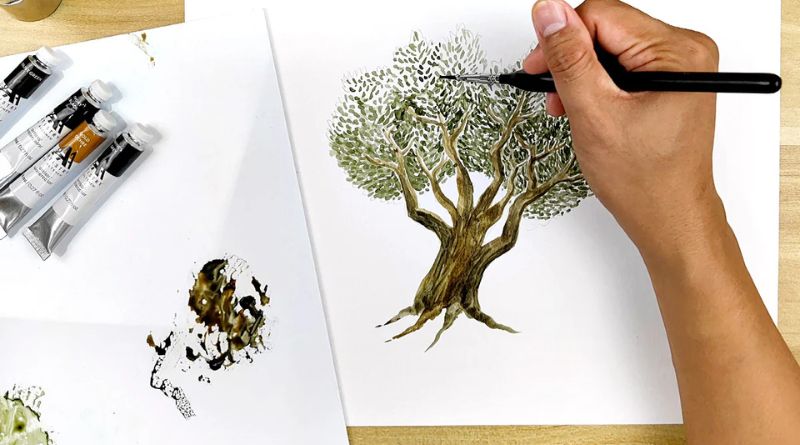Drawing is a timeless form of self-expression, creativity, and relaxation. Whether you are a beginner looking to develop your skills or an experienced artist seeking fresh inspiration, the possibilities of what to draw are endless. This article explores a variety of ideas for things to draw, organized by categories to suit different moods, styles, and skill levels. From simple doodles to intricate works of art, there’s something for everyone.
Table of Contents
1. Nature and Landscapes
Nature has always been a popular subject for artists, and for good reason. The variety of colors, textures, and shapes in the natural world provides endless opportunities for exploration. Here are some ideas to get you started:
- Trees and Forests: Draw a tall, majestic tree with gnarled roots, or a dense forest filled with different types of trees. Pay attention to the texture of the bark and the foliage.
- Mountains and Valleys: A mountainous scene can be awe-inspiring, whether you choose a snowy peak, a rocky cliff, or a lush green valley. Experiment with shading to create depth and atmosphere.
- Rivers and Waterfalls: Capturing the fluid motion of water can be a challenge, but it’s also incredibly rewarding. You could try drawing a river winding through a valley or a powerful waterfall cascading over a cliff.
- Seasons: Illustrate different seasons by focusing on the changes in the landscape. Spring flowers, summer beaches, autumn leaves, and winter snow all offer unique visual elements.
2. Animals and Wildlife
Animals are not only beautiful and fascinating but also offer a great opportunity to practice different drawing techniques, such as shading, texture, and proportion.
- Domestic Animals: Start with cats, dogs, or other pets. These creatures offer a great chance to practice capturing personality and emotions through facial expressions and body language.
- Wild Animals: Lions, tigers, and elephants are classic choices, but you can also get creative by drawing more exotic or lesser-known animals like lemurs, pangolins, or axolotls.
- Birds and Insects: From soaring eagles to delicate butterflies, drawing birds and insects allows you to experiment with both large and small details.
- Underwater Life: Dive into the ocean and sketch fish, sea turtles, and whales. Consider adding texture to the scales and experimenting with the effects of water on light and color.
3. People and Portraits
Drawing the human figure is one of the most challenging and rewarding aspects of art. If you’re new to figure drawing, start simple and gradually increase the complexity of your subjects.
- Portraits: Capture a person’s likeness with detailed facial features. Start with basic shapes to outline the head, eyes, nose, and mouth, then refine the details with shading and texture.
- Full-Body Figures: Move beyond the face and try drawing a full-body figure. You can practice by sketching people in different poses, either from reference photos or live models.
- Expressions and Emotions: Experiment with drawing different facial expressions such as happiness, sadness, surprise, or anger. This will help you understand how subtle changes in the face can convey emotion.
- Fashion and Costumes: Draw people in elaborate clothing or historical costumes. This is a great way to practice fabric textures and folds, as well as adding depth and dimension to clothing.
4. Fantasy and Imagination
If you enjoy letting your imagination run wild, the world of fantasy and surrealism offers a wealth of opportunities. Here are some ideas to explore:
- Dragons and Mythical Creatures: Bring mythical creatures like dragons, unicorns, or griffins to life with intricate details such as scales, feathers, and magical elements.
- Fairy Tales and Legends: Draw scenes inspired by classic fairy tales, like Cinderella, Sleeping Beauty, or Little Red Riding Hood. You can also invent your own characters and stories.
- Futuristic Robots or Aliens: Imagine beings from another world, whether they are highly advanced robots or strange extraterrestrial life forms. Focus on unique shapes and mechanical details.
- Abstract Concepts: Create surreal art by combining various objects or concepts in a dream-like manner. Think of floating islands, distorted timepieces, or animals morphing into other objects.
5. Still Life and Everyday Objects
Drawing still life scenes is a great way to practice observation and improve your technical skills. Everyday objects often contain interesting shapes and textures that can be quite fun to sketch.
- Food: Draw a plate of fruit, a bowl of soup, or a slice of cake. Focus on texture and light reflection, especially with shiny surfaces like glass and metal.
- Books and Stationery: Illustrate an open book with pages turning, a pencil case, or an old typewriter. These objects allow you to practice fine details and complex textures.
- Tools and Instruments: Try drawing a vintage camera, a musical instrument like a guitar, or a collection of tools. These objects usually have a lot of intricate details to capture.
- Plants and Flowers: Experiment with drawing potted plants, blooming flowers, or even a single leaf. Focus on the organic shapes and patterns found in nature.
6. Cartoons and Comic Characters
If you enjoy lighthearted or humorous drawings, cartooning can be a lot of fun. You don’t need to be a professional illustrator to create interesting and engaging characters.
- Classic Cartoon Characters: Try drawing iconic characters like Mickey Mouse, Bugs Bunny, or characters from your favorite animated series. This can help you practice simplification and exaggeration of shapes.
- Create Your Own Characters: Design original characters with unique personalities. You can sketch them in different poses or with various facial expressions to bring them to life.
- Comic Strips or Panels: If you’re feeling ambitious, create a short comic strip or comic book panel. Work on character design, visual storytelling, and incorporating text bubbles.
7. Abstract and Conceptual Art
If you’re looking to experiment and push boundaries, abstract art allows for limitless creativity. You can explore shapes, colors, and forms without the need to represent reality.
- Geometric Shapes: Create a series of intricate patterns or tessellations using geometric shapes like squares, triangles, and circles.
- Color Studies: Use color to convey emotion or mood. Experiment with bold contrasts, gradients, and blending techniques to create visually striking compositions.
- Lines and Doodles: Draw simple or complex doodles using only lines. Play with curves, spirals, and repetitive patterns that create a sense of movement or rhythm.
FAQs
What are some easy things to draw for beginners?
For beginners, it’s best to start with simple objects and gradually build your skills. Some easy things to draw include basic shapes like circles and squares, simple animals like cats and dogs, or still life objects like a cup, fruit, or a plant.
How do I improve my drawing skills?
Improving your drawing skills requires consistent practice and patience. Start by focusing on basic drawing techniques like shading, perspective, and proportions. Use reference materials to help you understand anatomy, light, and texture. Over time, experiment with different styles and subjects to develop your own artistic voice.
Can I draw if I don’t have much artistic talent?
Absolutely! Drawing is a skill that anyone can improve with practice. Don’t worry about being perfect right away. Start with simple sketches, and over time you will notice your progress. The most important thing is to enjoy the process and not to be overly critical of your work.
What should I draw when I don’t feel inspired?
When inspiration is low, try drawing something from your everyday surroundings. Sketch a cup of coffee, the view from your window, or your favorite pair of shoes. Alternatively, drawing from your imagination, such as creating a fantasy scene or abstract art, can spark new ideas.
How do I draw more realistically?
To draw more realistically, focus on developing your observation skills. Study how light affects the objects you are drawing, and pay close attention to details like shadows, textures, and proportions. Practice drawing from life or reference photos, and use techniques like cross-hatching and blending to add depth and realism to your sketches.
No matter your experience level, there’s always something new and exciting to explore in the world of drawing. Whether you prefer realism, fantasy, or abstract art, the possibilities are endless. So, pick up a pencil, start sketching, and let your creativity flow!



